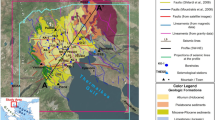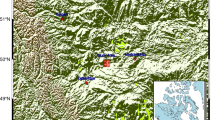Abstract
Based on the sensitivity of geophysical response to gas hydrates contained in sediments, we studied the prediction of gas hydrates with seismic techniques, including seismic attributes analysis, AVO, inverted velocity field construction for dipping formations, and pseudo-well constrained impedance inversion. We used an optimal integration of geophysical techniques results in a set of reliable and effective workflows to predict gas hydrates. The results show that the integrated analysis of the combination of reflectivity amplitude, instantaneous phase, interval velocity, relative impedance, absolute impedance, and AVO intercept is a valid combination of techniques for identifying the BSR (Bottom Simulated Reflector) from the lower boundary of the gas hydrates. Integration of seismic sections, relative and absolute impedance sections, and interval velocity sections can improve the validity of gas hydrates determination. The combination of instantaneous frequency, energy half attenuation time, interval velocity, AVO intercept, AVO product, and AVO fl uid factor accurately locates the escaped gas beneath the BSR. With these conclusions, the combined techniques have been used to successfully predict the gas hydrates in the Dongsha Sea area.
Similar content being viewed by others
References
Ecker, C., Dvorkin, J., and Nur, A. M., 2000, Estimating the amount of gas hydrate and free gas from marine seismic data: Geophysics, 65, 565–573.
Ewing, J. I., and Hollister, C. D., 1972, Regional aspects of deep sea drilling in the western North Atlantic: in: Hollister, C. D., and Ewing, J. I., Eds, Initial Reports of the Deep Sea Drilling Program, 11, U. S. Government Printing Office, Washington, D. C., 951–971.
Gao, J. R., Teng, J. W., Li, M., and Zhang, Y. J., 2006, AVO fluid inversion: theory and practice: Petroleum Exploration and Development (in Chinese), 33(5), 558–561.
Holbrook, W. S., Hoskins, H., Wood, W. T., Stephen, R. A., Lizarralde, D., and Leg 164 Science Party, 1996, Methane hydrate and free gas on the Blake Ridge from vertical seismic profiling: Science, 273, 1840–1843.
Hyndman, R. D., and Davis, E. E., 1992, A mechanism for the formation of methane hydrate and seafloor bottom simulating reflectors by vertical fluid expulsion: J. Geophys. Res., 97, 7025–7041.
Katzman, R., Holbrook, W. S., and Paull, C. K., 1994, Combined vertical-incidence and wide-angle seismic study of a gas hydrate zone, Blake Ridge: J. Geophys. Res., 99, 17975–17995.
Kvenvolden,, K. A., 1988, Methane hydrates and global climate: Glob. Biogeochem. Cycl., 2, 221–229.
Liu, X. W., Nian, J. B., and Wu, H. B., 2005, Comparison of seismic impedance inversion methods and application case: Global Geology, 24(3), 270–275.
Markl, R. G.., Bryan, G. M., and Ewing, J. I., 1970, Structure of the Blake-Bahama outer ridge: J. Geophys. Res., 75(4), 539–455.
Rutherford, S. R., and Williams, R. H., 1989, Amplitudeversus-offset variations in gas sands: Geophysics, 54(6), 680–688.
Sun, P. Y., Sun, J. G., and Lu, X. L., 2004, PP2 wave AVO analysis with elastic parameters: Petroleum Exploration and Development (in Chinese), 31(3), 86–88.
Wang, X. P., Chen, B., Sun, W. Z., Zhang, H. M., and Zang, D, G., 2005, Interpretation of the pinch-out belt in YW3 Well field using relative amplitude preserved high resolution pressing data: Petroleum Exploration and Development (in Chinese), 32(1), 63–66.
Wu, B. X., Lei, H. Y., Duan, Y., and Zhang, H., 2004, Experimental simulation on equilibrium temperature and pressure of methane hydrate in sediment systems: Petroleum Exploration and Development (in Chinese), 31(4), 22–28.
Zhang, G. X., Huang, Y. X., and Chen, B. Y., 2003, The seismology of gas hydrate in the sea area: Ocean Press, Beijing, China.
Zhang, Y., 2006, Application and prospect of 3D seismic pre-stack time migration processing technique: Petroleum Exploration and Development (in Chinese), 33(5), 536–541.
Zhang, Y. W., Liu X.W., and Yao, C.l.. 2005, Recognition of gas hydrate using AVO-attribute crossplots based on the porous medium theory: Applied Geophysics, 2(1), 7–13.
Zeng, Z., Yan, S. X., Wei, X. C., and Liu, Y., 2003, Analysis and counter measurement of seismic prediction in the Sulige Gas Field: Petroleum Exploration and Development, 30(6), 63–67.
Author information
Authors and Affiliations
Corresponding author
Additional information
This research was supported by National Gas Hydrates Integral Appraisal Project (GZH200200203-05).
Liu Yanjun Senior Engineer, graduated from DaQing Petroleum University. He mainly engages in seismic processing and interpretation, reservoir prediction, and comprehensive research. Currently he is studying for his PhD at China University of Geosciences (Beijing), majoring in Petroleum Geology and Engineering.
Rights and permissions
About this article
Cite this article
Liu, Y., Liu, X., Liu, D. et al. Applications of seismic techniques to gas hydrates prediction. Appl. Geophys. 5, 67–73 (2008). https://doi.org/10.1007/s11770-008-0006-6
Received:
Revised:
Published:
Issue Date:
DOI: https://doi.org/10.1007/s11770-008-0006-6




